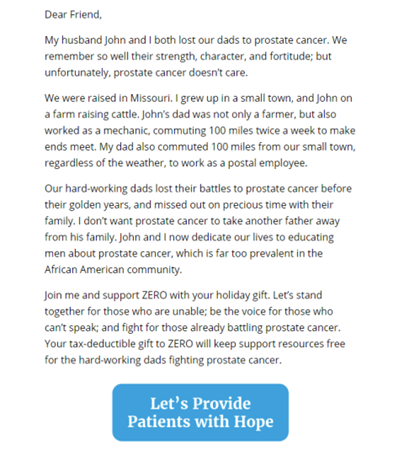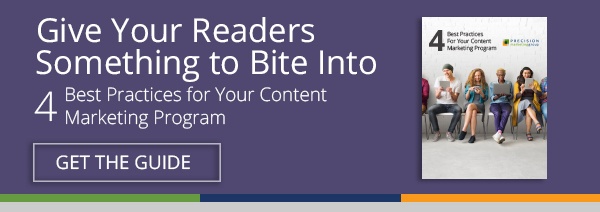I’m a marketing copywriter by day and fiction writer by night (or the early morning or whenever I can snatch ten minutes here, five minutes there).
Fiction is my passion. Copywriting pays the rent. But that doesn’t mean my fiction world is completely separate from my copywriting life.
In fact, I rely on plenty of storytelling techniques in my marketing copy—techniques that all content marketers should consider keeping in their writer toolboxes.
1. Show (don’t tell).
Fiction writers will feel me on this one. The idea behind the “show; don’t tell” directive is that it’s much more compelling to demonstrate (typically through a scene) what you’re trying to convey rather than simply stating it.
So a skilled fiction writer won’t simply say the main character is incredibly romantic; the writer will demonstrate through a scene how the person leaves post-it notes with love quotes all over his girlfriend’s apartment.
When it comes to copywriting, the concept of “show; don’t tell” typically involves features vs. benefits, which is something most copywriters are likely familiar with. Listing features is all about telling—you’re stating the product’s or service’s ABCs. Boring, right? But when you share the benefits, you’re showing the reader why this product or service will rock her world.
Other ways to show instead of tell:
- Testimonials. First-person testimonials provide that all-important “social proof,” which shows the prospect why the product/service/company is so great.
- Visuals. Visuals are a great way to demonstrate—to show—the message you’re trying to get across. Think images, infographics, charts, explainer videos, and so forth. For example, instead of saying your corporate culture is “fun,” show people what you mean through a video that highlights employees’ interesting personalities, the awesome office layout, and the many dogs that linger by people’s desks.
2. Think concrete vs. abstract, unique vs. ordinary.
The next time you pick up a novel, notice how the author describes a person. The most talented writers will focus on something other than traits like hair color, eye color, and height. Instead, the writer might show the way the protagonist rolls her lower lip between her teeth when she’s nervous or the flicker that passes over the man’s eyes when he catches a whiff of lilacs, which reminds him of his dead mother.
See how those particular details are so much more distinctive—and provide insight at the same time? That’s what you want to shoot for when you’re drafting copy. When talking with clients, always keep your eyes and ears open for that truly remarkable “thing.”
An example: I’m currently working with a large medical practice. Now medicine is medicine, right? I mean, there are just so many ways you can describe a surgical procedure or a doctor’s background. But here’s something that is distinctive about this particular medical practice: the COO is also a patient. In fact, he was a patient first. Then, he became the COO. THAT is an interesting story (and shows the quality of this medical practice without my having to directly state it). It’s a concrete example as well—something that people will likely remember.
3. Get personal.
There’s nothing quite like an engaging memoir, one that provides an unflinching look at the author’s real life. Why do we love these revealing tell-alls so much? Three reasons. First, it’s usually memorable. Second, there’s typically a larger, universal theme at work, one that most people can relate to. Third, it’s honest—and people love honesty.
Adding a dose of “real life” to marketing copy can have the same effect on the reader, and perhaps even more so, since people often expect a tired “spin” in business writing. So before drafting copy, determine if there’s a way to make it more personal.
Below is a great example—an email I received from a nonprofit called ZERO – The End of Prostate Cancer.

Short, sweet, to the point, but highly personal—talk about effective!
I’m using this strategy for Management Mentors, a client I’ve written about before. January is National Mentoring Month, so the WHOLE team (the president, sales manager, marketing folks) will all be penning personal posts about their first mentors.
4. Add suspense.
Who doesn’t love a good mystery, right? A little whodunit? An OMG-what-is going-to-happen-next moment? We’re talking suspense, baby, something you’d be surprised to know you can add to your copy.
No, we’re not suggesting you go Gone Girl on the new white paper you’re drafting, but one thing you can do is add a little suspense to compel the reader to keep reading. So how do you create suspense in copywriting?
Lead with a provocative question, but don’t answer it right away. This is a common strategy in headlines:
- What’s the Most Effective Way to Match Mentors and Mentees?
- What’s the #1 Natural Remedy for Bad Breath?
- What’s Your Personal Trainer’s Biggest Gripe about Clients? (The Answer Might Surprise You)
When you start writing these articles, you won’t give the answer in the first paragraph. You’ll likely build up to the answer, which adds suspense and keeps the reader reading. For example, in the bad breath scenario above, you might discuss other natural remedies that do and don’t work and reveal the #1 remedy at the very end.
5. Add tension.
A tense-filled plot always makes for good reading. A fight between lovers, a bad guy getting away, a protagonist walking into a trap…we keep reading because we want to see how it will all work out. In other words, we’re reading for the eventual ease in tension.
You can do the same with copy. Present something uncomfortable—a problem—which will create instant tension. Then, work towards the ease in that tension by presenting the solution.
You’ll often see this approach in TV commercials. Here’s a classic one from my childhood (that I was thinking about the other day—DON’T ASK). It sets up the problem—an icky problem that we can all identify with—and eases the tension by delivering a solution. For those who remember it, enjoy this blast from the past!
Can you think of any other storytelling techniques that content marketers should consider using in their copy? We want to hear them! Share in the comments.
And, of course, get in touch if you’d like PMG to take your content marketing to the next level.




